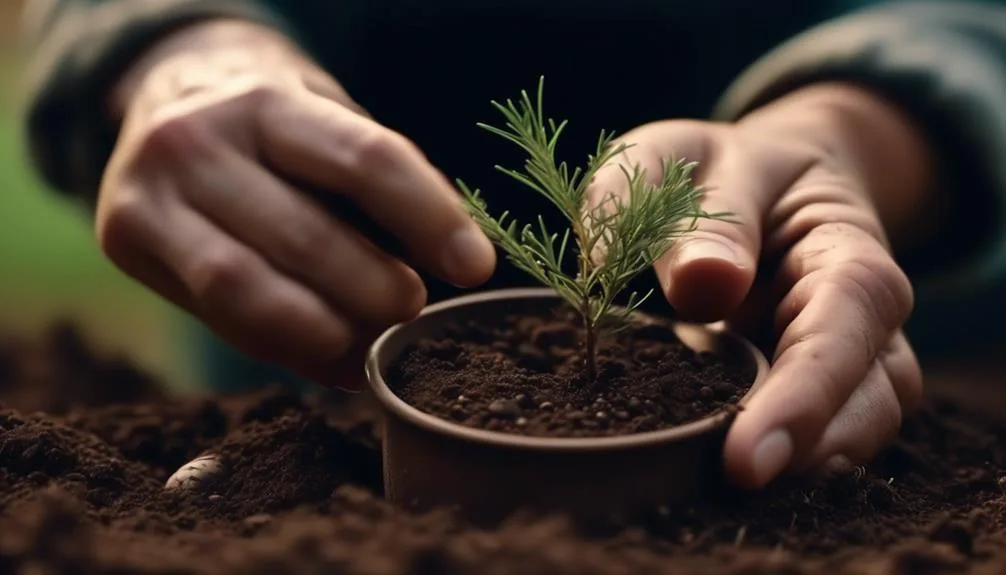Dreaming of majestic cedar trees in your backyard? Wondering how to grow them from seed? It's an exciting yet manageable process. From collecting seeds to nurturing saplings, we'll guide you through cultivating these beautiful trees.
Whether you're a seasoned gardener or just starting out, the satisfaction of growing your own cedar trees is within reach.
Seed Collection
When collecting cedar tree seeds, it's important to choose mature cones that have just started to open, allowing you to gather the seeds at their peak ripeness. Look for cones that are brown and slightly open, indicating that the seeds are ready for collection.
To collect the seeds, gently shake the cones over a container to release them. Once collected, store the seeds in a cool, dry place in a breathable container such as a paper bag. Proper seed storage is crucial to maintain their viability.
When you're ready to begin the germination process, soak the seeds in water for 24 hours to soften the hard seed coat. This will help to kickstart the germination process and improve the chances of successful seedling development.
Seed Preparation
After collecting the mature cedar tree seeds from the cones, the next crucial step is to prepare the seeds for germination by soaking them in water for 24 hours to soften the hard seed coat. This process helps to break seed dormancy and promote successful germination. Once the seeds have been soaked, it's important to ensure moisture control and temperature regulation for optimal germination conditions. Here's a simple guide to help you with seed preparation:
| Seed Preparation | |
|---|---|
| Step 1 | Soak the seeds in water for 24 hours to soften the seed coat. |
| Step 2 | After soaking, remove the seeds and place them on a moist paper towel. |
| Step 3 | Keep the paper towel moist and store it in a plastic bag. |
| Step 4 | Place the bag in a warm, well-lit area to encourage germination. |
Planting Process
Consider preparing the soil by mixing in organic matter to improve drainage and fertility. Select a well-draining site with plenty of sunlight exposure for optimal growth. Clear the area of any weeds or debris before planting your cedar tree seeds.
Plant the seeds at the appropriate depth, typically about twice the diameter of the seed. Water the seeds thoroughly after planting, ensuring that the soil remains consistently moist but not waterlogged.
As the seedlings begin to grow, provide regular watering and monitor soil moisture levels. Once the seedlings have established, prune any damaged or crowded branches to promote healthy growth.
Proper sunlight exposure, soil preparation, watering, and pruning are essential for the successful growth of cedar trees from seed.
Care and Maintenance
To maintain healthy cedar trees, regularly inspect the foliage for signs of pests or disease and promptly address any issues that arise. Additionally, proper pruning techniques and ensuring soil fertility are crucial for the well-being of your cedar trees. When it comes to pruning, it's essential to remove any dead or diseased branches to encourage healthy growth and prevent the spread of infections. Moreover, maintaining soil fertility by using organic mulch and periodic fertilization will provide the necessary nutrients for robust growth. Below is a table summarizing key care and maintenance tasks for cedar trees:
| Care and Maintenance Tasks | Description |
|---|---|
| Inspect foliage | Check for pests and diseases |
| Pruning techniques | Remove dead or diseased branches |
| Soil fertility | Use organic mulch and fertilize periodically |
Transplanting and Growth
When transplanting cedar trees, ensure that the new location provides adequate sunlight and well-draining soil to support healthy growth.
Consider the following key points:
- Root Development: Gently spread out the roots when transplanting to encourage outward growth and stability. Avoid bending or damaging the roots, as this can hinder the tree's ability to establish itself in its new location.
- Soil Moisture: Water the transplanted cedar tree thoroughly after planting to settle the soil and provide essential moisture for root development. Monitor the soil moisture regularly, ensuring it remains consistently moist but not waterlogged, especially during the tree's initial growth phase.
- Sunlight Exposure: Choose a location with ample sunlight for optimal growth. Cedar trees thrive in full sunlight, so ensure the new site receives at least 6-8 hours of direct sunlight daily to support healthy growth.
Conclusion
With the right steps and patience, you can grow cedar trees from seeds and nurture them into majestic additions to your backyard. Witnessing their growth, from tiny seeds to thriving trees, brings the reward of your efforts.
Embrace the journey of planting and nurturing these beautiful cedar trees, knowing that with care and dedication, they'll flourish and enrich your surroundings.
Happy planting!

My interest in trees started when I first saw the giant sequoias in Yosemite.
I was a teenager then, and I remember thinking, “I need to learn more about this.”
That moment stuck with me.
A few years later, I went on to study forestry at Michigan Tech.
Since graduating, I’ve worked in a mix of hands-on tree care and community education.
I’ve spent over ten years helping people understand how to plant, maintain, and protect the trees in their neighborhoods.
I don’t see trees as just part of the landscape.
They are living things that make a real difference in our daily lives.
